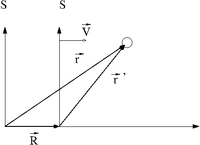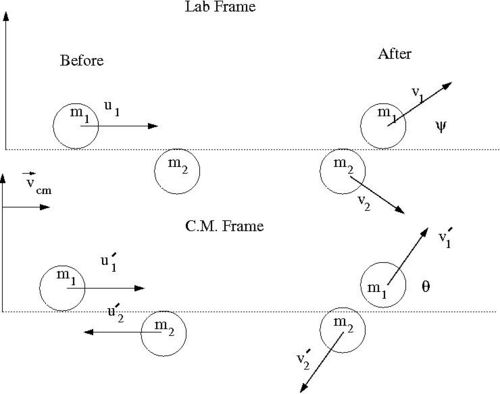Difference between revisions of "Forest UCM NLM GalileanTans"
| Line 1: | Line 1: | ||
[[File:TF_UCM_GalileanTans_RefFrame.png | 200 px]] | [[File:TF_UCM_GalileanTans_RefFrame.png | 200 px]] | ||
| + | [[File:TF_UCM_GalileanTans_RefFrame.xfig.txt]] | ||
Assume that <math>S^{\prime}</math> is a coordinate system moving at a CONSTANT speed <math>v</math> with respect to a fixed coordinate system <math>S</math>. | Assume that <math>S^{\prime}</math> is a coordinate system moving at a CONSTANT speed <math>v</math> with respect to a fixed coordinate system <math>S</math>. | ||
| Line 34: | Line 35: | ||
Newton's law hold in coordinate system which move at a constant velocity (an inertial reference frame). Accelerating reference frames are know as non-inertial reference frames and will be discussed later. (a coordinate system fixed to the Earth is a non-inertial reference frame since the Earth is rotating about its axis and moving in orbit about the Sun) | Newton's law hold in coordinate system which move at a constant velocity (an inertial reference frame). Accelerating reference frames are know as non-inertial reference frames and will be discussed later. (a coordinate system fixed to the Earth is a non-inertial reference frame since the Earth is rotating about its axis and moving in orbit about the Sun) | ||
| + | |||
| + | =Galiean Transformation to CM frame= | ||
| + | |||
| + | [[Image:SPIM_ElasCollis_Lab_CM_Frame.jpg | 500 px]] | ||
[[Forest_UCM_NLM#Galilean_Transformations]] | [[Forest_UCM_NLM#Galilean_Transformations]] | ||
Revision as of 12:59, 20 August 2014
 File:TF UCM GalileanTans RefFrame.xfig.txt
File:TF UCM GalileanTans RefFrame.xfig.txt
Assume that is a coordinate system moving at a CONSTANT speed with respect to a fixed coordinate system .
Let and describe the position an object in motion using two different coordinate systems and respectively.
represents a vector that locates the origin of the moving reference frame () with respect to the origin of reference from .
Using the definition of vector addition
Similarly
and
Newton's law of motion may be written as
If
- is moving at a constant velocity
Then
Newton's law hold in coordinate system which move at a constant velocity (an inertial reference frame). Accelerating reference frames are know as non-inertial reference frames and will be discussed later. (a coordinate system fixed to the Earth is a non-inertial reference frame since the Earth is rotating about its axis and moving in orbit about the Sun)
